Victorian-South-London
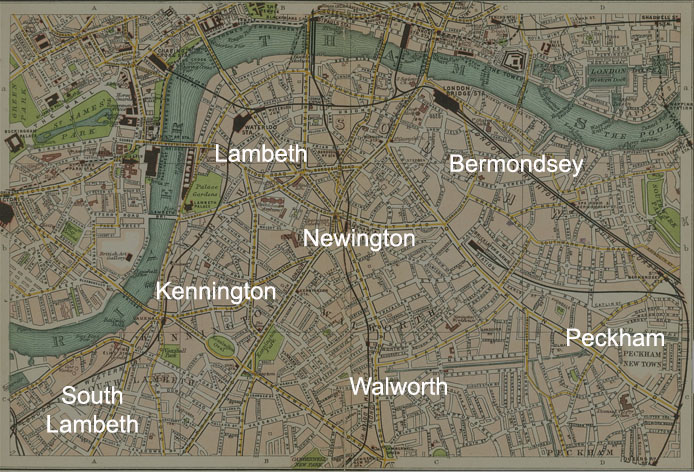
|
Bermondsey
Class: Primarily Lower Class and Criminal, with a sprinkling of Middle Class.
A low-lying parish in Surrey, adjoining Southwark, long-famous for its mill-streams, since converted into open ditches and sewers, covered and filled in as recently as 1849, when the ravages of the cholera rendered their removal absolutely necessary. Bermondsey is a primarily Catholic district, and is well-known for its various stream-mills and other larger refineries, including at least one chemical site and a large tannery that provides most of the district's work. Residents are known for the "Bermondsey look," with pale cold skin and dark circles under the eyes. They usually have the sniffles as well. It is a busy place, with close-packed streets.
- Physical: Access -2, Safety -2.
- Mental: Information -1, Awareness -2
- Social: Prestige -3, Stability -1
- Sanctum Qualities: Security limited to 2 dots; Size limited to 2 dots.
- System: Those who live primarily in Bermondsey must make a Stamina + Resolve roll once per season, with a -1 penalty for every season lived there. Failure on this roll inflicts the Flaw: Bermondsey Look, which grants a -1 penalty to Social rolls in dealing with middle or upper-class individuals, and a -1 penalty to Stamina checks to resist disease.
St. Saviour & St. Marie Overie Cathedral
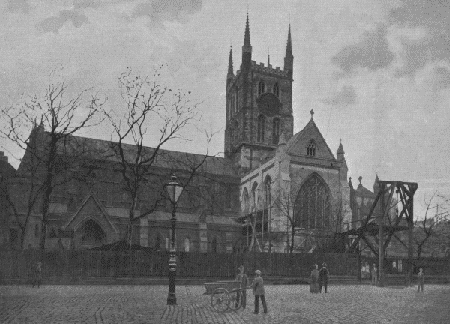
|
St. Saviour's, Southwark, within a few minutes' walk of London Bridge Station, is one of the finest parish churches in the kingdom. Before the Reformation it was known as the Priory Church of St. Mary Overy. The tower, 35 feet square and 150 feet high, is a very solid structure. In 1840 the nave was rebuilt, but in so wretched a fashion that it had to be replaced by another, from the designs of Sir Arthur Blomfield, who undertook a thorough restoration of the fabric, with a view to St. Saviour's becoming a cathedral for South London. The poet John Gower is buried in the south transept, and in the church also lie Edmund Shakespeare, a brother of the poet, Philip Massinger, John Fletcher, and other dramatists and actors who were connected with the old Bankside theatres.
- Locations: X
- Traits: Size X, Security X; Advantages: X; Status X, Durability X, Structure X
Guy's Hosptial
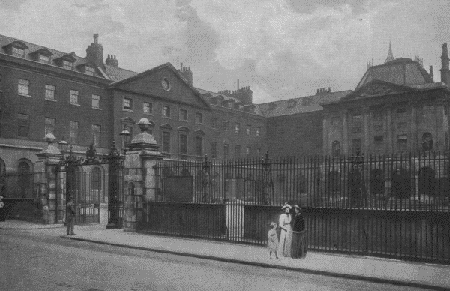
|
This famous institution was founded by Thomas Guy, a bookseller, who made an immense fortune either by trading in Bibles or by speculating in South Sea stock. The Hospital, which is situated in Southwark, a short distance from London Bridge, was built in the years 1722-25, but considerable additions to it have since been made. Our picture shows the front of the building, with one of the wings in the courtyard is a bronze statue of the pious founder, who did not live to see the Hospital occupied. Guy's has on the average 411 beds occupied every day, but is able to accommodate 500 patients, and in the course of the year some 5,000 in-patients and 70,000 out-patients are treated. The yearly income is about £20,000; and there is a flourishing medical school.
- Locations: X
- Traits: Size X, Security X; Advantages: X; Status X, Durability X, Structure X
Southwark Park
Southwark Park has been formed within the last ten years in the dreary district beyond the Bermondsey tan-yards.
- Locations: X
- Traits: Size X, Security X; Advantages: X; Status X, Durability X, Structure X
Kennington
Class: Middle, with a sprinkling of Lower Class
- Physical: Access X, Safety X
- Mental: Information X, Awareness X
- Social: Prestige X, Stability X
- Sanctum Qualities: X
A working class neighborhood whose only real landmark is Kennington Oval and Kennington Park.
Kennington Manor-House
A portion of the royal lodging built of brick upon part of the site of the old palace near Kennington-cross, exists to this day. Its last royal tenant was Charles I., when Prince of Wales, Kennington having been an occasional residence of the Kings of England prior to the Conquest. The manor was annexed to the Duchy of Cornwall, temp. Edward III., and was tenanted by the Black Prince. John of Gaunt took refuge here in 1377 from the exasperated Londoners. Henry VII. and Katherine of Arragon resided here; and James I. settled the manor on Henry Prince of Wales, his eldest son; and upon his decease, 1612, on Prince Charles, afterwards Charles I. The stables of the earlier palace, built of flint and stone, and known as the Long Barn, remained till 1795; and fragments of flint, chalk, and rubble-stone walls of the ancient palaces are traceable in houses in Park-place.
Vauxhall Gardens
A set of walled gardens set aside for dining and entertainment. Paying customers are ushered into the pavilions and gardens of Vauxhall and treated to sumptuous meals while watching all sorts of entertainment, from Wild West shows to Arabian Nights Entertainments, to all manner of theater and musical performances. The Vauxhall Orchestra is known as a rowdy gathering of musicians far beyond the "sophisticated" sorts who normally play in orchestras, and the Gardens employ all manner of folk, from jugglers and acrobats to dancing girls and strongmen. Vauxhall opens during the late Spring, and closes during early Autumn.
Kennington Park
Once the site of public executions until 1800, Kennington Park is really little more than a large square, and contains only about a dozen acres. It is, however, prettily planted, and occupies the site of the old Kennington-common, the scene of the memorable Chartist fiasco of 1848. There are, however, a gymnasium and two planted gardens. The park was enclosed in 1852 and forbidden "gathering or vulgar recreation" there, in light of the Chartist gatherings.
- Locations: X
- Traits: Size X, Security X; Advantages: X; Status X, Durability X, Structure X
Lambeth
Class: Middle, with a sprinkling of Lower Class; Upper Class around Lambeth Palace
- Physical: Access X, Safety X
- Mental: Information X, Awareness X
- Social: Prestige X, Stability X
- Sanctum Qualities: X
Working class neighborhood and bureaucratic center of the Southwark.
St. George Cathedral
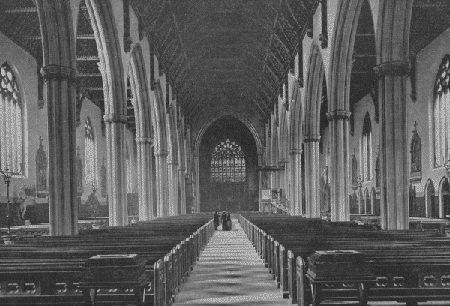
|
It is rather curious that at the very spot where Lord George Gordon's "No Popery " rioters assembled at the end of the last century, St. Georges Roman Catholic Cathedral should have been erected. Pugin, the architect, followed the Gothic style, and the work of building was begun in 1840 and dubbed, with the exception of the tower, in 1848, the cost being £35,000. The Cathedral, which nearly faces Bethlehem Hospital, is badly cramped for space by the surrounding roads. Inside it is 240 feet long by 70 feet wide. The handsome pulpit is constructed of Caen stone. While the chancel and some parts of the Cathedral compel admiration, the general effect of the interior is undeniably bare. It was here that Dr. Wiseman was installed Archbishop of Westminster.
- Locations: X
- Traits: Size X, Security X; Advantages: X; Status X, Durability X, Structure X
Bethlehem Hospital (Bedlam)
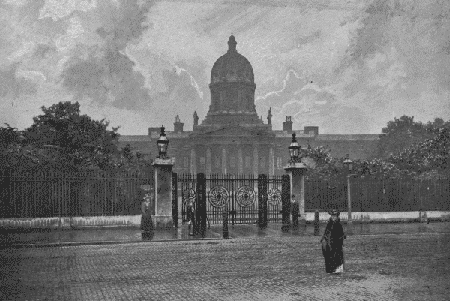
|
Bethlehem Hospital, colloquially known as Bedlam, has been a madhouse since the time of Henry VIII. The present building in St. Georges Fields, Lambeth, only dates from early in the present century, and has been more than once enlarged. The Hospital was first situated in Bishopsgate Street, and was superseded in 1675 by a building in Moorflelds, and this by the structure shown above. The front, 900 feet long, is rendered very imposing by its Ionic columns. Over the portico is inscribed: Henrico VIII. rege fundatum civitum largitas perfecit. Lewis was the architect of the building, but the dome was added later by Smirke. The Asylum has accommodation for four hundred patients of both sexes.
- Locations: X
- Traits: Size X, Security X; Advantages: X; Status X, Durability X, Structure X
St. Thomas's Hospital
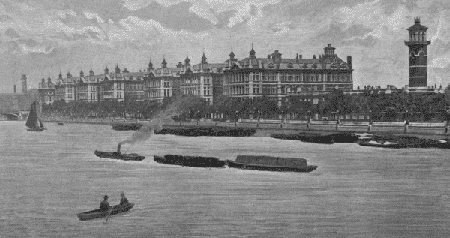
|
St. Thomas's is indubitably the finest hospital yet erected stretching along the Surrey side of the Thames from Westminster Bridge towards Lambeth Palace, and facing the Houses of Parliament. The Hospital was founded in 1228, but the present building, by Currie, reared at a cost of half a million, only dates from 1871, the old premises in Southwark having just before this been sold to the South Eastern Railway Company. In the Palladian style, it consists of eight red-brick, stone-faced pavilions, united by arcades; the whole structure being 1,700 feet long by 250 feet deep. St. Thomas's contains nearly six hundred beds, and in the course of the year some 5,000 in-patients and 80,000 out-patients are treated. The income of the Hospital is £40,000.
- Locations: X
- Traits: Size X, Security X; Advantages: X; Status X, Durability X, Structure X
Waterloo Station
Main omnibus and train station, running from 9 AM to 9 PM. Just outside of Waterloo Station is the so-called "Necropolis Station," the stopping point for the once-daily funeral trains that carry coffins to Brookwood Cemetary in Surrey, the cemetery set aside for London's departed.
- Locations: X
- Traits: Size X, Security X; Advantages: X; Status X, Durability X, Structure X
Lambeth Palace
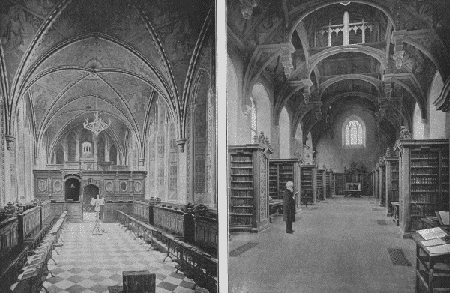
|
This quaint old building, for centuries the official residence of the Archbishops of Canterbury, is situate nearly opposite to the Houses of Parliament. The Lollard’s Tower the chapel, the great hall, the great dining-room, and the magnificent library, which contains a remarkable collection of MSS., black letter tracts, &c. are the principal attractions. The picture gallery and the guard chamber contain many curious portraits. Two of the most interesting parts of Lambeth Palace are the Chapel and the Library. The former, Early English in style, is the oldest part of the London residence of the Archbishops of Canterbury, and dates from Archbishop Bonifaces time -1245. It is 72 feet long by 26 feet broad, and is bisected by a handsome carved screen, raised by Archbishop Laud, to whom also the windows are due.
The Library of Lambeth Palace, founded by Archbishop Bancroft early in the seventeenth century, now contains thirty thousand books and two thousand manuscripts and since 1834 it has been housed in the Hall, a room 92 feet long by 40 feet broad, built by Archbishop Juxon in 1663. Except on Saturdays, it is open to the public during the greater part of the year.
The Lollards' Tower at Lambeth Palace is really the Water Tower, and only since the beginning of last century has it been believed that Wycliffe's followers were incarcerated here. In the upper part of the tower is the room once used as a prison, dating probably from the thirteenth century. It forms part of a staircase turret, and is 13_ feet long, 12 feet wide, and 8 feet high. On the walls may still be seen the inscriptions of prisoners who were chained to the rings. As stated on an earlier page, the poet Lovelace, on account of his Royalist principles, and the Earl of Essex, who for a time enjoyed Queen Elizabeth's favour, were here held in durance.
- Locations: X
- Traits: Size X, Security X; Advantages: X; Status X, Durability X, Structure X
Lambeth Workhouse
A house for the poor and homeless, notorious for miserable living conditions, rampant abuse and crime.
- Locations: X
- Traits: Size X, Security X; Advantages: X; Status X, Durability X, Structure X
Newington
Class: Middle, with a sprinkling of Lower; Upper Class in the Paragon Circle
- Physical: Access X, Safety X
- Mental: Information X, Awareness X
- Social: Prestige X, Stability X
- Sanctum Qualities: X
A perfectly respectable middle-class neighborhood, and the social center of the Southwark, Newington features a variety of craftsmans and tradesman's shops and homes, as well as a couple of small theaters and other entertainment areas. There are even a pair of night-houses tucked away in the lower class areas of the district.
Peckham
Class: Middle, with a sprinkling of Lower and Criminal
- Physical: Access X, Safety X
- Mental: Information X, Awareness X
- Social: Prestige X, Stability X
- Sanctum Qualities: X
Peckham, on the Surrey side, between two and three miles SE. from London-bridge, lies for the most part rather low, but on gravelly soil. The large open common of Peckham Rye, and is neighbour, Goose-green, are on higher ground; the ascent continuing to Nunhead and Honor Oak, which latter stands about on a level with the Crystal Palace. Houses are to be had in the lower part of Peckham at a rent as low as £30 a year, but they are of course small. As the ground rises in situation the rents rise with it; and though they never attain the standard of such situations as Sydenham, Richmond, &c., they are considerably beyond what would be required for houses of the same class at a similar distance on the northern side of town. Taken altogether, however, the Peckham district may be considered, as in proportion to its advantages, one of the cheapest in London.
South Lambeth
Class: Upper and Middle, with a sprinkling of Lower
- Physical: Access X, Safety X
- Mental: Information X, Awareness X
- Social: Prestige X, Stability X
- Sanctum Qualities: X
Definitively in more suburban areas, South Lambeth has absorbed the upper class folk who fled the Lambeth area around the turn of the century. The lower class homes are primarily along the river, where the homes of dockworkers and longshoremen are.
Walworth
Class: Middle and Lower.
- Physical: Access X, Safety X
- Mental: Information X, Awareness X
- Social: Prestige X, Stability X
- Sanctum Qualities: X
A distinctly working class neighborhood, with little to differentiate it from its surrounding working class areas.